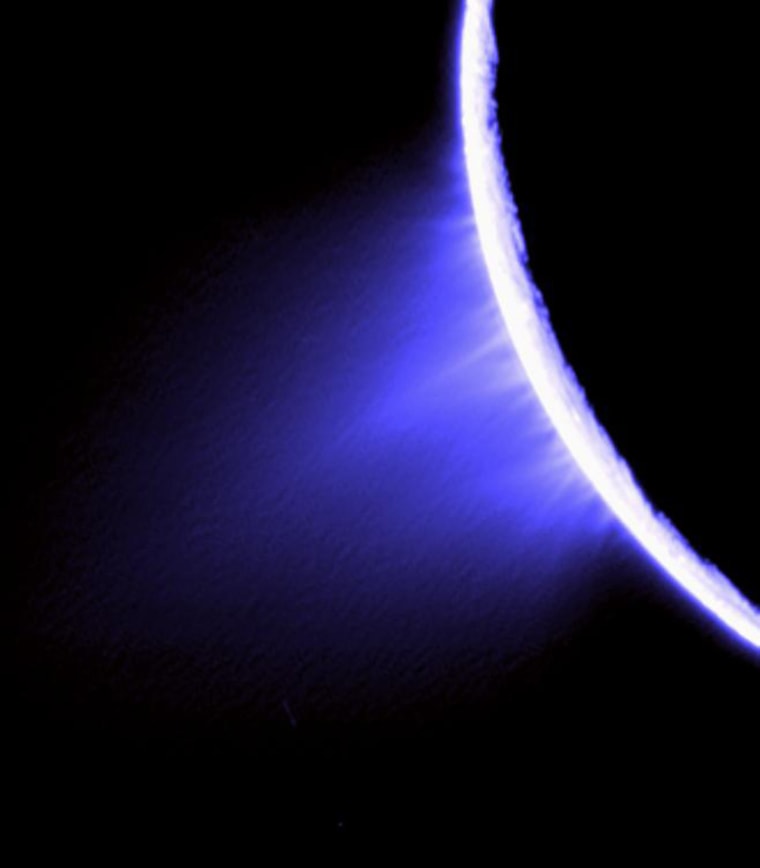The tide may be changing for the ocean suspected under the icy shell of Enceladus. Recent research has shown that this small moon of Saturn does not produce enough heat in its present configuration to keep water from freezing down to its core.
"There is no possible combination of parameters that allow for a thermally stable ocean," said James Roberts of the University of California, Santa Cruz.
Roberts and his colleague Francis Nimmo, also from UCSC, calculated the tidal heating expected inside Enceladus from the uneven tugging of nearby Saturn.
In all the models studied, the moon could not sustain an ocean for more than around 30 million years.
This could mean the ocean froze up long ago. Or perhaps more likely, Enceladus generated a greater amount of heat at some point during the past 30 million years by being in a more eccentric orbit than it is in now, the authors claim in a recent article for the journal Icarus.
Thermal surprise
Scientists did not always think Enceladus had an ocean.
"Normally the smaller a planet or satellite is, the colder it is," Roberts explained. "Since Enceladus is roughly the size of Great Britain, everyone assumed it would be dull and boring."
But observations during several flybys of NASA's Cassini spacecraft in 2005 showed surprising thermal activity on the south pole.
Plumes of water vapor were detected erupting out of the surface, and infrared measurements showed 5.8 gigawatts of heat emanating from several narrow ridges called "tiger stripes."
"It's a no-brainer that tidal heating is happening on Enceladus," said William McKinnon of Washington University in Saint Louis. "I can conceive of no other explanation for the south polar thermal anomaly."
Tidal heating results from the elliptical orbit of Enceladus. As the moon's distance to Saturn varies, the tidal pull from the planet causes the moon to squeeze in and stretch out. The friction from this strain generates heat.
The phenomenon is well-known on the moons Io and Europa. Io is one of the most volcanically active bodies in the solar system thanks to tidal heating from its orbit around Jupiter.
However, significant tidal heating on Enceladus is only possible if there is an ocean separating the icy shell from the solid silicon core. Without that liquid lubricant, the moon would be too rigid to flex in and out.
And as a catch-22, the ocean will freeze without significant tidal heating. This is because the only other source of heat — radioactive decay inside the core — is expected to be an insufficient 0.32 gigawatts.
Freeze down
Roberts and Nimmo were interested in probing how far down Enceladus' proposed ocean would likely be.
They tested various models, varying both the thickness of the icy shell and its deformation properties. They also looked at different ways that heat might flow through Enceladus.
Enceladus' tidal heating has been calculated before, but Roberts and Nimmo are the first to show how the heating is distributed through the shell, with more at the poles than the equator.
They were surprised to find that heat escapes Enceladus faster than it is generated. Therefore, if Enceladus's orbital eccentricity has always been what it is today, the moon would have frozen completely solid billions of years ago.
"And once it froze, tidal heating would have been shut off forever," Roberts said.
Lunar anti-freeze
But in all likelihood, there is some kind of ocean on Enceladus, so something must have prevented Enceladus from fully freezing.
"There has to be an ocean to allow the flexing — that's a well-founded conclusion," McKinnon said.
Slideshow 12 photos
Month in Space: January 2014
Although McKinnon thinks this new work is important, he does not think it covers all possible scenarios. For one, he believes the water in the Enceladus ocean will be full of salts and maybe ammonia. Such a mixture will freeze at a lower temperature than pure water.
McKinnon also said that the ocean itself will generate tidal heating by sloshing back and forth like the ocean tides do on our planet.
But even including these other elements, Enceladus may still not retain enough heat to allow for an ocean to exist today. This is why Roberts and Nimmo consider the possibility that the moon has migrated from a more eccentric orbit in the past.
If Enceladus' orbit had been three times more eccentric than it is now, the tidal heating would have been enough to keep an ocean. Assuming this high eccentricity (high heating) phase ended within the last 30 million years, the moon would not yet have had enough time to freeze up. The researchers speculate that the moon's eccentricity and tidal heating may have fluctuated up and down many times.
The orbital history of Enceladus is not known, but migration of satellites is not unheard of, McKinnon said.
Astrobiologists considering the suitability of Enceladus to life may have to incorporate a dynamic ocean that has shrunk and expanded over million-year timescales in response to the moon's fluctuating eccentricity.
Scientists will not be able to confirm these predictions anytime soon as a mission to penetrate Enceladus' icy depths would be extremely difficult, Roberts said.

